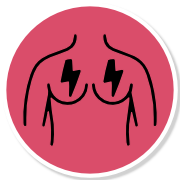

Period Calculator and Period Tracker
Menstruation, also called the menstrual cycle, menses, or menstrual period, is a natural and vital process in a woman’s life, and is often surrounded by questions and misconceptions. The menstrual cycle is a series of changes that a female body goes through every month to prepare for possible pregnancy. This cycle can tell you about your overall health, especially if you track it regularly. This article delves into the details of the menstrual cycle, how to calculate the next period, signs of its onset, reasons for its irregularities, and some important facts every woman should know.
What is the Menstrual Cycle?
The menstrual cycle refers to the sequence of events within the body as it prepares for pregnancy every month. The pituitary gland (nervous system) and the ovaries (reproductive system) release certain hormones at certain times during the cycle. These hormones cause the lining of the uterus to thicken, so that an egg can be implanted in the uterus if pregnancy occurs. The hormones also cause the ovaries to release an egg through the fallopian tube where it waits for the sperm. If the sperm doesn’t fertilize the egg, i.e. pregnancy does not take place, the egg along with the uterine lining breaks down and sheds. This is called the menstrual period.
The entire menstrual cycle takes place in 3 phases – follicular, ovulation, and luteal phase:
Follicular Phase
With a slight overlap during menstruation, the follicular phase begins on the first day of your period and lasts up to 13 days. This is the time when the hypothalamus signals the pituitary gland to release follicle-stimulating hormone (FSH). The FSH causes the ovaries to produce 5 to 20 small sacs called follicles, each containing an immature egg. Eventually, only the healthiest egg matures while the rest of the follicles are reabsorbed by the body. The maturing follicle leads to a spike in estrogen levels that thickens the lining of the uterus. This is to create a nutrient-rich environment for an embryo to grow.
Ovulation Phase
An increase in estrogen further signals the pituitary gland to release lutenizing hormone (LH) which results in the ovulation phase. Ovulation is when the ovary releases a mature egg and waits for it to be fertilized by the sperm.
If you have a 28-day cycle, ovulation occurs on Day 14, i.e. right in the middle of your cycle and lasts for about 24 hours. In case your cycle length varies, you can use a time period calculator to determine your exact day of ovulation.
Luteal Phase
The luteal phase takes place from day 15 to day 28, in a 28-day cycle. After ovulation, if you do get pregnant, the body produces human chorionic gonadotropin (hCG), which is the hormone pregnancy tests detect. If you do not get pregnant, the estrogen and progesterone levels will reduce and cause the onset of your period.
Calculating your Menstrual Cycle
If you are trying to get pregnant or if you’re simply wondering whether or not your cycle is regular, it is important to keep track of it. You can track your cycle and understand which phase you are in at any time during the month by using a period calculator. Today, it is fairly easy to find a period calculator online. Another way to calculate the next period is to determine the length of your cycle.
The menstrual cycle starts on the first day of your period until the next first day of your period. On average, the cycle lasts anywhere between 24 to 38 days. It is important to note that the length of the cycle varies from woman to woman as well as month to month, owing to seasonal, dietary, mental health and other medical conditions.
Women suffering from hormonal imbalance or medical conditions like polycystic ovarian syndrome may experience frequent irregularities in their cycles. If you have been noticing changes in your regular cycle, consult your gynaecologist to discuss the best course of action for you.
Signs Your Period is Coming
Changes in the body are imminent during different phases of the menstrual cycle. You can anticipate the onset of your period by using a period calculator and noticing the changes for yourself. There are also period cycle calculator apps that allow you to track your physical and emotional symptoms so you can understand your cycle more closely.

Hormonal spikes in the menstrual cycle lead to breast discomfort.
Premenstrual syndrome (PMS) causes emotional and physical changes like irritability, food cravings, and, in severe cases, depression and anxiety.
Lowered progesterone levels cause water retention, resulting in bloating before menstruation.
Hormonal fluctuations may trigger acne, often seen as red bumps in the lower face, resolving after menstruation.
Dysmenorrhea, or cramps, occur before and during menstruation as the uterus sheds its lining.
Increased progesterone level causes cloudy or white vaginal discharge before menstruation.
Hormonal spikes in the menstrual cycle lead to breast discomfort.
Premenstrual syndrome (PMS) causes emotional and physical changes like irritability, food cravings, and, in severe cases, depression and anxiety.
Lowered progesterone levels cause water retention, resulting in bloating before menstruation.
Hormonal fluctuations may trigger acne, often seen as red bumps in the lower face, resolving after menstruation.
Dysmenorrhea, or cramps, occur before and during menstruation as the uterus sheds its lining.
Increased progesterone level causes cloudy or white vaginal discharge before menstruation.
Signs Of Period Coming Late:
Home pregnancy tests can confirm if you’re pregnant.
Chronic stress disrupts hormone balance; relaxation techniques help.
Sudden weight fluctuations can delay periods; consult a doctor or nutritionist if needed.
Conditions like PCOS, diabetes, and thyroid issues, along with certain medications, can affect your menstrual cycle.
Menopause typically occurs between 45-55; early menopause (POI) can begin as early as 40.
Delayed periods before menopause, called perimenopause, usually starts in women in their 40s.
Home pregnancy tests can confirm if you’re pregnant.
Chronic stress disrupts hormone balance; relaxation techniques help.
Sudden weight fluctuations can delay periods; consult a doctor or nutritionist if needed.
Conditions like PCOS, diabetes, and thyroid issues, along with certain medications, can affect your menstrual cycle.
Menopause typically occurs between 45-55; early menopause (POI) can begin as early as 40.
Delayed periods before menopause, called perimenopause, usually starts in women in their 40s.






The menstrual cycle is a miraculous process of the body and is an important aspect of reproductive health. You can better manage your menstrual as well as overall health by using reliable period calculator tools to keep track of your cycle and your body’s reaction to it. Lastly, it is important to keep in mind that every woman’s cycle is unique and varies depending on their age, lifestyle, stress levels, and underlying medical conditions.
The menstrual cycle starts on the first day your period until the next first day of your period. On average, the cycle lasts anywhere between 21 to 35 days. You can calculate your period by first determining the average length of your cycle. Keep a count of the number of days between your period for the last few cycles. Then add up the total number of days and divide it by the number of cycles. This gives you the average number of days in your period.
You can use the period calculator by following some quick and easy steps.
- Find a period calculator online or download a period calculator app
- Input the date of the first day of your last cycle
- Input your average cycle length
- Input the number of days your period lasts
- Click on Calculate
This information will give you a rough prediction of your future periods. Some period calculators also provide additional information such as the days when you will be ovulating, or the types of symptoms you may experience in every phase.
Tender breasts, feeling bloated, period acne, menstrual cramps, mood swings, and dry discharge are some signs that your period is coming.
A period is said to be late when it doesn’t start on the expected date of your next cycle. Clear milky white and excessive discharge, lower abdomen pain, fatigue, nausea, tender breasts, etc. are some signs of a late period.
Detecting patterns in your cycles is the first step to determining whether you have irregular periods. You can also track your ovulation time to determine the next period date. Cervical mucus secretion and basal body temperature both tend to slightly increase before and during ovulation. You can notice these changes or use ovulation predictor kits to know when you’re ovulating and determine an approximate date of you your next period.
Your next period date is based on your average cycle length and the regularity of your periods. Since the cycle length varies between 21 to 35 days, period dates may change every month.
If there are no underlying conditions, your period must start within 21 to 35 days, depending on your cycle. A delay of up to 7 days is considered normal and more than 6 weeks is considered to be a missed period.
If your cycle is almost always on time but you’ve been noticing unusual delays, it is best to seek advice and eliminate any underlying health issues.
Foods rich in antioxidants, iron, calcium and vitamins are known to regulate periods. Some of these include papaya, aloe vera, pineapple, carom and fennel seeds, whole grains, berries, flaxseeds, leafy vegetables, fatty fish, avocado, dark chocolate, etc.
Some foods that can naturally delay your periods include apple cider vinegar, lemon juice, gelatin, gram lentil soup, cinnamon, watermelon, chia seeds, cucumber, raspberry leaves, etc.
Pregnancy is the most plausible reason for a delayed or missed period. However, other reasons apart from pregnancy include being on birth control medication, health conditions like PCOS, stress, changes in your body weight, diabetes or thyroid issues, and perimenopause.
If you think your period is regularly delayed, consult your doctor to determine the cause and address issues, if any.
If you’re new to a period calculator, it will take a few cycles for the calculator to understand your pattern. The period calculator uses information such as your last period date, the length of your period, and the number of days between each cycle to determine your next period date.
Without the calculator, you can calculate your menstrual cycle by marking the beginning and end of your cycle in your calendar or in your notebook. Track your cycle for a couple of months and you’ll be able to determine the average length of your cycle, which will help you predict your next period date. You’ll also begin to notice the changes in your physical and emotional states, that indicates which phase you might be in during your cycle.


 Toll Free Number
Toll Free Number






